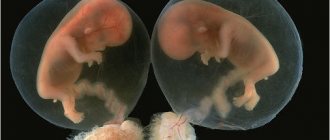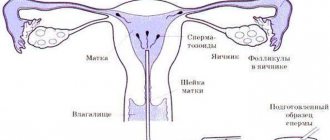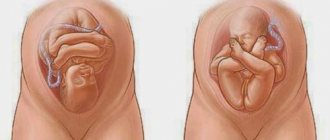Causes of antenatal fetal death
There are several reasons for pregnancy loss, they differ depending on the period.
In the early stages
The early stages of pregnancy include the period from 9 to 21 weeks. Antenatal fetal death at this stage of embryo development can occur for the following reasons:
- detection of a sexually transmitted disease in a pregnant woman;
- a malformation of the embryo incompatible with further development;
- Rhesus conflict;
- severe stress or prolonged overexertion;
- excessive abuse of bad habits: alcoholism or nicotine addiction;
- a pregnant woman has suffered from diseases incompatible with pregnancy, such as rubella or chicken pox;
- development of intrauterine fetal hypoxia.
Throughout the first trimester, the fetal body is just beginning to form. Therefore, any negative interference contributes to the disruption of this process.
In the later stages
The late stages include the 2nd half of pregnancy (from 21 to 42 weeks). The reasons for pregnancy fading at this stage include:
- the formation of an inflammatory process in the genital organs of a woman;
- late toxicosis;
- entwining the fetus with the umbilical cord around the neck;
- mother falling or a strong blow to the abdomen;
- placental abruption;
- contact of a pregnant woman with toxic substances;
- taking medications that are incompatible with pregnancy;
- oligohydramnios;
- polyhydramnios.
Regardless of the duration of pregnancy, the causes of antenatal fetal death can be a fall of the mother, hormonal imbalances, acute food poisoning and taking medications that are incompatible with pregnancy.
Immune and autoimmune factors
Recently, the immunological factor has become increasingly common. Since the fertilized egg consists half of the father’s genetic information, the expectant mother’s body can perceive it as a foreign body. This provokes the production of antibodies that interfere with the development of the fetus. In other words, the embryo is rejected by the woman’s immune system.
A large number of antibodies to phospholipids found in the blood plasma causes the appearance of autoimmune disorders. The first place among them belongs to antiphospholipid syndrome. Almost 5% of cases of fetal freezing occur due to the presence of this pathology. With subsequent pregnancies, this figure increases to 42%. The main reason for the appearance of this syndrome is heredity. The pathology provokes the formation of blood clots and significantly complicates the situation during pregnancy.
Symptoms and diagnosis of antenatal fetal death
The main signs of antenatal fetal death are:
- cessation of all signs of pregnancy: toxicosis, engorgement of the mammary glands;
- absence of fetal movements for more than a day, during late pregnancy;
- lack of baby's heartbeat;
- decreased tone and cessation of the uterus;
- the appearance of nagging pain in the abdominal area;
- in rare cases, bleeding from the vagina occurs.
If such symptoms appear, you should immediately consult a gynecologist. The specialist will independently assess the baby’s mobility and heartbeat using a cardiotocography or electrocardiography device. But, an ophthalmologist can accurately make a diagnosis after an ultrasound examination.
Diagnostics
After a woman contacts a gynecologist with suspicions of pregnancy pathology or comes for a routine examination, the doctor refers her to diagnostic procedures that will make it possible to make a final diagnosis and decide on the necessary measures. Among the simplest and most accurate methods for diagnosing antenatal death of a baby are the following.
- Ultrasound . Allows you to determine the absence of heartbeat and blood flow, the location of the deceased fetus, its size, the condition of the placenta and amniotic fluid.
- ECG . Allows you to determine the absence of cardiac impulses in the fetus.
- FKG . By analogy with an ECG, it determines the absence of a heartbeat in the fetus.
Intrauterine antenatal multiple fetal death in late stages
A global stress for the mother is the death of the fetus in the late stages.
She prepares a nursery for him, feels him inside her, and suddenly it all disappears. The risk of miscarriage increases markedly with multiple pregnancies. If one baby died in utero, this may not at all affect the full development of the second baby, but only if this happened in the early stages of pregnancy. A dead embryo can disappear on its own; medical experts call this phenomenon the disappearing baby phenomenon. But a healthy twin is in danger if the death of the second occurs later than the 20th week of pregnancy. In this case, the risk of his death is 38%, in addition, the chances of developing the formation of various pathologies and lesions of the central nervous system significantly increase.
Clinical manifestations
A pathognomic sign of pathology is the absence of uterine growth. Up to 14–16 weeks, the cessation of growth of the fetal sac is determined by a gynecological two-hand examination; in later periods, there is a lack of increase, and sometimes a slight decrease in the abdominal circumference and the height of the uterine fundus. The pregnant woman notes the disappearance of fetal movements, increased or decreased tone of the fetal sac. The engorgement and soreness of the mammary glands disappear. When a dead fetus remains in the uterus for 2 weeks or more, general health deteriorates, weakness with malaise, discomfort and pain in the lower abdomen occur. An increase in body temperature indicates infection of the dead fetus and requires emergency measures. In the later stages, a characteristic symptom of the pathology is the absence of a fetal heartbeat during auscultation.
Treatment
If, as a result of a diagnostic examination, antenatal fetal death is confirmed, then the woman’s health is in serious danger; in any case, it is necessary to consult a specialist and go to the hospital for drug treatment.
When fetal death occurs in the early stages, in most cases, spontaneous miscarriage occurs. If this does not happen, then the woman is under anesthesia and has her uterus cleaned.
In the second trimester, the possibility of spontaneous miscarriage and curettage disappears.
In order to expel the dead fetus from the uterine cavity, a caesarean section is performed or labor is induced. The obstetrician-gynecologist should conduct an examination and, as soon as the birth canal is ready, should determine which treatment method is most appropriate.
In the third trimester, when fetal death occurs, doctors stimulate labor with special medications.
After the expulsion of the dead fetus from the uterine cavity, the patient should be under the supervision of medical workers for a long time; if her condition stabilizes, then 3-7 days after the artificial birth she is sent home.
Studies confirming the diagnosis
If there is a suspicion of intrauterine fetal death, the pregnant woman must be urgently hospitalized. To reliably confirm the diagnosis, FCG and ECG are used. Their results can confirm or deny the presence of heartbeats. An ultrasound examination of the fetus, which is also mandatory in this situation, in the early stages of pregnancy will help to see the absence of breathing and heartbeat, as well as blurry contours of the body. A little later, it can be used to detect the decomposition of the body.
Amnioscopy is one of the methods by which the condition of the waters and fetus is diagnosed. During this procedure, on the first day after the death of the fetus, a green tint of amniotic fluid can be detected. Later they acquire a less intense color and a blood admixture appears. The skin of the fetus has the same color. By pressing the amnioscope on the part of the fetus that is presenting, you can see the depression. This is explained by the lack of tissue turgor.
Quite rarely, X-ray examinations are used, during which it is possible to observe disturbances in the condition of the fetus:
- its size does not correspond to the period of pregnancy;
- flattened arch and blurred contours of the skull;
- the arrangement of the bones is imbricated;
- drooping lower jaw;
- curved spine;
- atypical nature of the arrangement of body members;
- decalcified skeleton.
Prevention
Unfortunately, there is no method that would definitely allow one to avoid the formation of antenatal death. But, there are several preventive measures that will significantly reduce the risk of this phenomenon occurring:
- You should avoid stressful situations and limit yourself from heavy physical activity;
- you should undergo all tests in a timely manner and carry out the necessary procedures to identify the risk of developing pathology at an early stage;
- it is necessary to limit yourself from drinking alcohol and smoking;
- There is no need to self-medicate; taking each medication should be discussed with your doctor.
A healthy lifestyle and a calm environment are the main factors for the full development and birth of a healthy baby.
According to statistics, antenatal fetal death in the first trimester occurs in 5% of cases, in the second and third trimester it is 1%.
How to prevent intrauterine fetal death
It is very difficult to accurately predict and prevent intrapartum death, since in some situations there are a number of factors that are completely impossible to influence. But in most cases, a competent approach to pregnancy planning and the responsibility of the expectant mother will reduce the risk of fetal failure and allow the safe birth of her baby.
Before planning a conception, doctors recommend that both spouses undergo a series of medical examinations and undergo the necessary tests to make sure there are no infections, diseases or other factors that could negatively affect a future pregnancy. If necessary, appropriate treatment will be prescribed.
A woman who is already pregnant needs to regularly visit a gynecologist at the antenatal clinic, not refuse to undergo tests and follow all the gynecologist’s recommendations. Such measures will help monitor the condition of the woman and her unborn child, as well as detect any deviations in time and take urgent measures if necessary.
And yet, the best prevention of problems during gestation is pregnancy planning. Doctors recommend in advance a herbal complex based on Altai herbs for easy conception and successful gestation - Seraphim's Collection. The remedy not only facilitates pregnancy, but also cures many chronic diseases.
Also, as a preventative measure, you should adhere to the following recommendations:
- Get rid of bad habits (drugs, alcohol, smoking).
- Any medications during pregnancy should be taken only on the recommendation of a doctor.
- Elimination of injuries, falls, and heavy physical exertion.
- Minimum stress and worries.
- If you have the slightest suspicion or symptoms indicating a problem, do not wait - contact your doctor immediately.
Video on the topic of intrauterine embryo death:
Forecasts
Intrauterine fetal death is a great psychological trauma for a woman.
In most cases, she experiences this tragedy very hard and needs quality psychological help. In the future, she can become pregnant again and carry a healthy baby, but gynecologists exercise special control over such patients. Antenatal fetal death is a huge loss. Only a healthy lifestyle and taking care of yourself and your baby will help you avoid it. If it was still not possible to save the baby, then it is worth taking immediate measures to expel it from the uterine cavity, otherwise the woman’s health will be at risk.
Impact of infectious diseases
Acute and chronic forms of infectious diseases are also a great threat to the life of the fetus. The most common cases of fetal death are in the presence of herpes, mycoplasmosis, chlamydia, etc. They may appear earlier. But during this period there is a significant decrease in the woman’s immunity, and because of this, any illness during pregnancy manifests itself more intensely.
In the first trimester, cytomegalovirus poses a great threat, which very often causes pregnancy to fail. But in later stages it provokes the appearance of various developmental defects.
But, unfortunately, it is not always possible to determine why antenatal fetal death occurred. The reasons for it often remain unknown.
Consequences
The death of a fetus is a very great tragedy and severe emotional stress for a woman. In order to realize this and fully experience it, it takes time, and in some cases, the help of a qualified psychologist.
In this situation, special attention should be paid to the health of the woman herself. If you contact a specialist as quickly as possible, as well as follow all recommendations, intrauterine fetal death will not cause very serious consequences for health. When such a pathology occurs, it is necessary to identify the cause that provoked it. This is necessary in order to reduce the risk of fetal death during subsequent pregnancies. Women are not recommended to become pregnant during the first 6 months after the antenatal death of the baby.
If a woman does not seek help in a timely manner, there is a huge risk of developing bacterial and infectious complications, as well as sepsis. All these changes occur due to the decomposition of the baby’s flesh and the entry of a huge amount of toxins into the blood of the expectant mother.
Treatment tactics when pathology is detected at different stages of pregnancy
Therapeutic tactics in this case depend on the gestational age at which the child’s death occurred. To remove the fetus from the mother's womb, they resort to artificial termination of pregnancy or emergency childbirth. The table contains detailed information about what treatment measures are carried out if the fetus died in the 1st, 2nd and 3rd trimesters of gestation.
| Duration of pregnancy at which intrauterine death of the child occurred, trimester | Measures taken | Description |
| 1 | Medical abortion | Artificial termination of pregnancy is carried out in a medical institution by curettage of the uterine cavity. |
| 2 | Forced delivery | After a complete examination of the patient’s body and determination of the state of blood coagulation function, labor is induced. For this purpose, estrogens, glucose, vitamins and calcium-containing drugs are used. After this, Oxytocin and prostaglandin drugs are administered. To speed up the first stage of delivery, amniotomy is used. |
| 3 | In the absence of labor, they resort to induction of labor. If there are medical indications, procedures are carried out whose main goal is the destruction of the fetus. When a child is diagnosed with hydrocele of the brain, frontal and pelvic intrauterine position, the risk of injury to the uterus and the serious condition of the woman in labor, a craniotomy is performed. When the fetus is transversely presented, decapitation or evisceration is used; if the shoulders are difficult to pass through the birth canal, cleidotomy is used. |
Complications during childbirth
They don't always go smoothly. Sometimes the pregnancy goes well, the baby and mother are healthy, but upon admission to the maternity hospital, bleeding suddenly begins, the umbilical cord falls out, or a number of other unplanned complications arise that require immediate response from doctors.
Among the causes of intrapartum fetal death are complications of childbirth with a narrow pelvis, incorrect position (transverse or oblique). The birth process itself may not go as nature intended. Here we can highlight incorrect insertion of the head and various complications of childbirth. Intrapartum fetal death can occur if obstetric technique is violated. During a home birth accompanied by an incompetent assistant, this probability increases many times over.
Surveillance history
In order to correctly establish the chain of events and monitor whether it was indeed intrapartum fetal death, obstetricians keep detailed records of observations of the pregnant woman. If the heartbeat is heard until admission to the delivery room, but a child is born without signs of life, it means that something happened at the very last moment. And here it is necessary to figure out whether a medical error was made or whether the developmental and presentation characteristics led to the intrapartum death of the fetus.
Stillbirth can occur antenatally if cardiac arrest occurs between 28 weeks and up to the day of delivery. It may be caused by abnormalities of the fetus and placenta. No doctor can predict all possible scenarios, despite the most thorough examination.
Main reasons
Intrapartum fetal death is a consequence of disruption of the birth process. And most often, asphyxia plays a major role. It is usually secondary, as it arises from many diseases and their complications. Infections (influenza, typhoid, pneumonia) and chronic diseases (malaria and syphilis) are of great importance. Intoxication of various etiologies, acute poisoning, toxicosis, and exposure to various types of drugs also have an effect. Impaired fetal cerebral circulation and intracranial injuries leave virtually no chance of survival. Therefore, the combination of asphyxia and birth trauma is considered the most dangerous.











